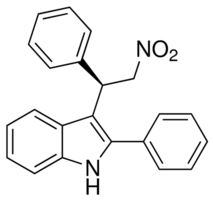All AbMole products are for research use only, cannot be used for human consumption.

For this product's availability, delivery time and price, please email [email protected] directly or click the "Inquiry Now" button below.
GAT228 is the R-(+)-enantiomer of GAT211, a positive allosteric modulator (PAM) of cannabinoid CB1 receptor signaling that was found to amplify the therapeutic effect of endocannabinoids without the negative side effects of psychoactivity or tolerance. GAT228 was found to be an unbiased CB1 allosteric agonist, while the S-(-)-enantiomer, GAT229,was found to be a potent, Gαi/o-biased CB1 PAM without intrinsic activity. In radioligand binding assays, both GAT228 and GAT229 behaved as PAMs of orthosteric ligand binding. Allosteric CB1R activation by GAT211 and its enantiomers could be a better therapeutic strategy for enhancing endogenous cannabinergic activity than targeting endocannabinoid-degrading enzymes with small-molecule inhibitors, with a lower likelihood of tolerance and dependence.
| Molecular Weight | 342.39 |
| Formula | C22H18N2O2 |
| CAS Number | 1446648-15-2 |
| Solubility (25°C) | DMSO: 20 mg/mL |
| Storage |
Powder -20°C 3 years ; 4°C 2 years In solvent -80°C 6 months ; -20°C 1 month |
[2] Luciana M Leo, et al. CB1 Cannabinoid Receptor Signaling and Biased Signaling
[5] Robert B Laprairie, et al. Enantiospecific Allosteric Modulation of Cannabinoid 1 Receptor
| Related Products |
|---|
| DSPE-PEG-FA
DSPE-PEG2K-FA is a PEG derivative containing folic acid. DSPE-PEG2K-FA has a targeting effect and can bind to folic acid receptors in cancer cells. DSPE-PEG2K-FA forms micelles/lipid bilayers and can be used in research on targeted drug delivery systems. |
| Lifastuzumab
Lifastuzumab is a humanized anti-NaPi2b IgG1 monoclonal antibody. |
| GPVI antagonist 1
GPVI antagonist 1 is a glycoprotein VI (GPVI) platelet receptor antagonist. GPVI antagonist 1 inhibits collagen-induced platelet aggregation with an IC50 of 25.3 μM. |
| MPSD TFA
MPSD TFA (MARCKS-ED TFA) is a 25-amino acid peptide based on the effector domain sequence of the intracellular membrane protein myristoylated alanine-rich C-kinase substrate (MARCKS). MPSD TFA can sense membrane curvature and recognize phosphatidylserine. MPSD TFA can be utilized as biological probe to study membrane shape and lipid composition. |
| 4-Nitro-2,1,3-benzoselenadiazole
4-Nitro-2,1,3-benzoselenadiazole is a biochemical material that can be used in scientific research. |
All AbMole products are for research use only, cannot be used for human consumption or veterinary use. We do not provide products or services to individuals. Please comply with the intended use and do not use AbMole products for any other purpose.


Products are for research use only. Not for human use. We do not sell to patients.
© Copyright 2010-2024 AbMole BioScience. All Rights Reserved.
